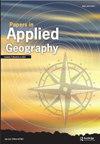Exploring the Utility of Gini Coefficients as a Measure of Temporal Variation in Public Transit Travel Time
Q2 Social Sciences
引用次数: 1
Abstract
Abstract Travel times by public transit vary dramatically throughout the day. However, these variations are not the same for all commutes. If one commute origin and destination are connected by high frequency transit all day, then that commute will have less variation in travel time throughout the day. This research illustrates how that variation can be measured with gini coefficients so that inequality in travel times can be better understood. Using Denver as a case study, gini coefficients are calculated with 120 travel times by public transit throughout the day for each of over 200,000 origin destination pairs. The utility of the gini coefficient as a predictor of the percent of the population that drives to work is then explored using a regression. The regression results indicate that the gini variable has utility in predicting the percent of the population that drives to work.探索基尼系数作为衡量公共交通出行时间时间变化的效用
一天中乘坐公共交通工具的时间变化很大。然而,这些变化并不适用于所有的通勤。如果一个通勤起点和目的地全天都有高频交通连接,那么该通勤在一天中的出行时间变化就会更小。这项研究说明了如何用基尼系数来衡量这种变化,以便更好地理解旅行时间的不平等。以丹佛为例研究,基尼系数以每天乘坐公共交通工具的120次旅行时间为基准,对超过20万对出发地和目的地进行计算。基尼系数作为驾车上班的人口百分比的预测指标的效用,然后使用回归来探索。回归结果表明,基尼变量在预测开车上班的人口百分比方面具有效用。
本文章由计算机程序翻译,如有差异,请以英文原文为准。
求助全文
约1分钟内获得全文
求助全文

 求助内容:
求助内容: 应助结果提醒方式:
应助结果提醒方式:


